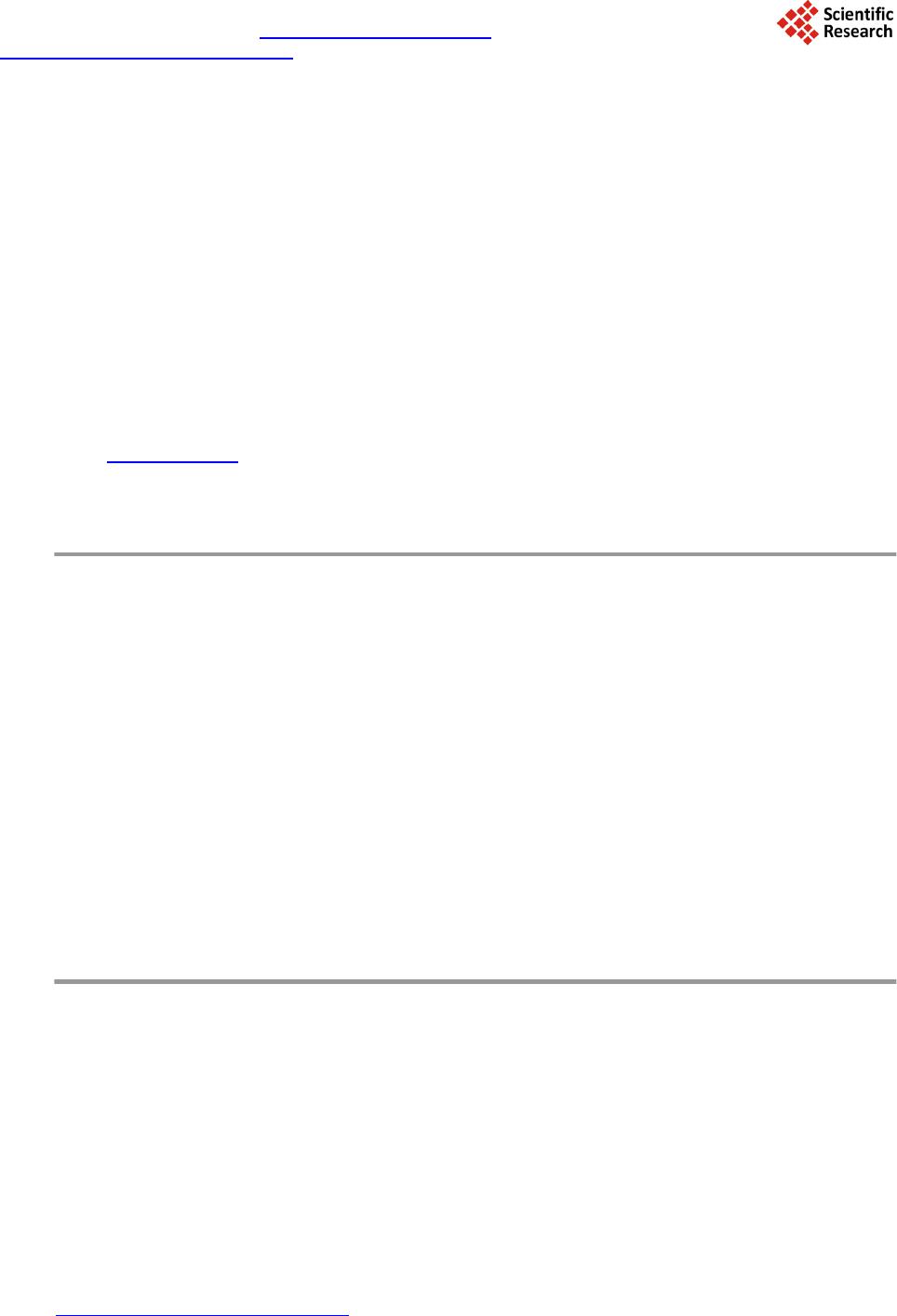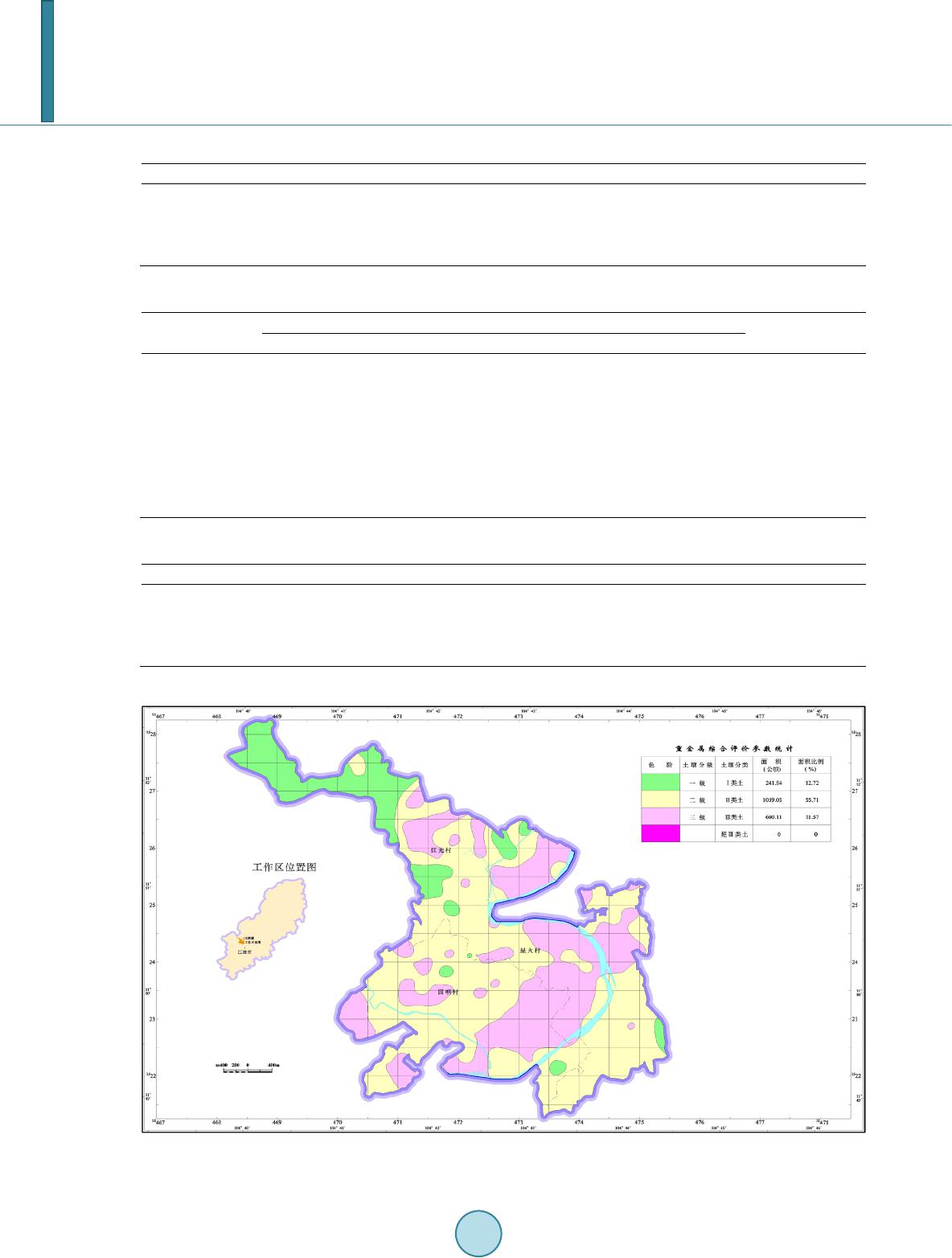 Journal of Geoscience and Environment Protection, 2014, 2, 28-35 Published Online April 2014 in SciRes. http://www.scirp.org/journal/gep http://dx.doi.org/10.4236/gep.2014.22005 How to cite this paper: Cui, D. X. et al. (2014). Evaluation on Ecological Risks of Soil Heavy Metals in a Certain Area of Si- chuan by Improved Fuzzy Mathematics Method. Journal of Geoscience and Environment Protection, 2, 28-35. http://dx.doi.org/10.4236/gep.2014.22005 Evaluation on Ecological Risks of Soil Heavy Metals in a Certain Area of Sichuan by Improved Fuzzy Mathematics Method Dongxia Cui1, Qiguo Zhao2, Wei Xu3 1Sichuan Normal University, SICNU, Chengdu, China 2Chengdu Polytechnic, CD P, Chengdu, China 3Chengdu University of Technology, CDUT, Chengdu, China Email: dx_cui@163.com Received Dec emb er 2013 Abstract Taking a certain area in Sichuan Province as the object of this study, this paper adopts fuzzy ma- thematics method to make an evaluation on ecological risks of heavy metal in soil of this area. On calculation of factors’ weights, the traditional method of giving weight according to pollutants’ concentrations fails to consider the toxicity of heavy metals, and can’t reflect their actual ecologi- cal effect. With reference to the toxicity coefficient in potential ecological risk index evaluation, this article revises the traditional fuzzy mathematics evaluation model and puts forward a new method to calculate factors’ weight by incorporating toxicity levels in weight setting. The results of this study indicate: surface soil of this area was good in general, with 91.2% samples belonging to the first level, 7.77% samples belonging to the second level, and only 1.03% belonging to the third level. Compared with the results of the evaluation method of the reality content of soil, soil quality is better than the results of the quantitative evaluation, and is closer to the actual local conditions. Keywords Fuzzy Mathematics; Heavy Metals; Soil Contamination; Evaluation 1. Introduction Heavy metal pollution of surface soil refers to the phenomenon that human activities cause significant higher concentration of heavy metals in surface soil compared with the background level, ecological damages and dete- rioration of environmental quality. In recent years, an increasing number of issues of heavy metal pollution have been reported, meanwhile, various methods of evaluation of it have also been proposed. Based on former re- searches, this paper adopts integrated fuzzy mathematics evaluation model to assess heavy metal pollution in surface soil of a certain area in Sichuan province. The results of assessment could provide basis for land re- structuring and industry restructuring.  D. X. Cui et al. 2. Material and Methods 2.1. Materials The study area, situated in Dakang town, Jiangyou city (31˚48'48" - 31˚52'35" N, 104˚39'51" - 104˚44'26" E), belongs to subtropical humid monsoon climate with average annual precipitation amount 1139mm, and annual average temperature 16.4˚C. In this area, ≥0˚C annual average accumulated temperature is 5844.6˚C, and ≥10˚C of the annual accumulated temperature is 5021.4˚C. Soil types are mainly purple soil and paddy soil, and the main vegetation type is subtropical coniferous forest. Agriculture is plantation-based, whose major agricultural products are rice, wheat, rape plant, corn, sweet potato, vegetables. 2.2. Study Methods 1) Sample Collection and Analytical Methods According to the principles of representation, homogeneity and controllability, 5 soil column samples were collected from the same soil type and land use type within a radius of around 30 m near the sampling point and then were blended into a combination of soil column sample. Among them, the sampling density is about 16 samples/km2 and sampling medium is 0 ~ 20 cm soil column to the surface. Regional field geochemical basic survey was taken in this area. 296 sampling points were selected from the surface soil, consisting of 179 from purplish soil and 117 from paddy soil. The soil samples were tested and analyzed by Chengdu Research Center for Land and Mineral Resources Supervision and Test, Ministry of Land and Mineral Resources. Detection me- thods and limits of heavy metals are shown in Table 1. 2) Comprehensive Fuzzy Mathematics Evaluation Method Comprehensive Fuzzy Mathematics Evaluation Method can exclude influence from subjective factors and keep objective. Therefore, it is effective to solve the fuzzy boundary among the degrees of heavy metal pollution and control the evaluation result errors. These can be widely applied to evaluation of soil environmental quality. Given that heavy metal pollution is gradual and fuzzy, pure quantitative method is unreasonable to distinct and quantify degrees of pollution with a clear line. While, fuzzy mathematics method is reliable since it can describe the progression and fuzziness of the pollution. 3) Standard for Heavy Metal Elements Evaluation Based on soil environmental quality standard GB15618-1995, soil environment quality is evaluated by se- lecting metal elements, such as: As, Cd, Cr, Cu, Hg, Pb, Ni, Zn, etc. The standard values can be seen from Table 2. 3. Detection Results and Analysis by Taking Fuzzy Mathematics Method 3.1. Heavy Metal Element Content-Comprehensive Evaluation 296 samples were selected from the surface soil in the study area. The characteristics of heavy metal elements content in the study area can be seen from Table 3. The table shows that a majority of elements are within nar- row limits, except for As, Cd, and Hg. Adopting MAPGIS spacial analysis, this paper generates Figure 1—a miniature of comprehensive evaluation by employing grid method to superimpose the heavy metal content in surface soil from the study area. The prin- ciple of superposition is to disqualify a higher level with a single lower value. If all indicators belong to first-level soil, it will be the first one—clearing zone—after the superposition. If there is an indicator belongs to second-level soil, it will be the second one—normal zone. Similarly, if there is an indicator belongs to the third or even higher level, it will be the third one—contaminated zone. As is shown in Figure 1, fi rst-level soil occupies 12.7%, second-level 55.7% and third-level 31.6%. 3.2. Fuzzy Mathematics Evaluation Methods Given there are three steps for fuzzy mathematics comprehensive evaluation, combined with the actual situation of this study area, this paper discusses: Step 1, 8 common heavy metals in soil are selected as evaluation indicators, namely Cd, As, Hg, Cu, Pb, Cr, Zn, Ni.  D. X. Cui et al. Table 1. Detection methods and detection limits for heavy metal elements (mg·kg−1). Element Method Detection Limits Element Method Detection Limits Cd ICPMS 0.03 Hg AFS 0.003 As AFS 0.5 Pb X fluorescence 2 Cr X fluorescence 5 Ni X fluorescence 2 Cu X fluorescence 1 Zn X fluorescence 4 Table 2. Soil environmental quality standard values (mg·kg−1). Element Grade I Grade II Gr ade II I Back ground value pH < 6.5 pH 6.5-7.5 pH > 7.5 Cd ≤0.2 0.30 0.30 0.60 1.0 Hg ≤0.15 0.30 0.50 1.0 1.5 As ≤15 30 25 20 40.0 Cu ≤35 50 100 100 400.0 Cr ≤90 150 200 250 400.0 Zn ≤100 200 250 300 500.0 Ni ≤40 40 50 60 200.0 Pb ≤35 250 300 350 500.0 Table 3. Characteristics of heavy metal elements content in the study area (mg· kg−1). Chemical par amet e rs As Cd Cr Cu Hg Ni Pb Zn Min 1.88 0.06 60.10 14.00 0.02 18.50 21.30 45.30 Max 31.66 1.26 209.10 97.90 1.00 89.50 53.60 147.10 Mean 10.92 0.32 87.36 31.12 0.09 36.22 33.75 90.36 SD 5.23 0.15 17.99 10.48 0.06 9.80 5.48 22.19 *n = 296. Figure 1. Comprehensive evaluation of heavy metal elements.  D. X. Cui et al. Step 2, fuzzy relationship matrix is established based on membership functions of evaluation factors, and then can be adopted to calculate the weighted values of evaluation indicators. Step 3, new fuzzy evaluation model is employed to calculate and generate the result. 1) Formation of membership function and fuzzy matrix Membership function can be used to describe the fuzzy boundary of the contaminated soil. Defining soil en- vironmental quality standard values in Table 2 as inflection points, each membership function of heavy metal contamination at various PH can be obtained by using the piecewise linear functions. The following are the 3 piecewise functions that are commonly used to describe heavy metal contamination in soil. Membership function of certain heavy metal in first-level soil is 1 ( )()/()| 0 ii iiiiii ii ii xa uxb xb aaxb xb ≤ = −−<< ≥ (1) Membership function of certain heavy metal in second-level soil is 0, ( )()/() ()/( ) iii i iiiiii ii iiiiii i x ax c uxx ab aaxb cxcbbx c ≤≥ = −−<≤ − −<< (2) Membership function of certain heavy metal in third-level soil is 0 ( )()/()| 1 ii iiiiiii i ii xb uxxbcbb xc xc ≤ = −−<< ≥ (3) Among the above piecewise functions, xi is the measured value, while ai, bi, ci are standard values for first-, second- and third -level environment quality respectively. According to the need for heavy metal evaluation in the study area, the indicator set U = {Cd, Hg, As, Cu, Pb, Cr, Zn, Ni} and evaluation set V = {first, second, third} are established. According to various pH values of the 296 surface soil samples selected from the study area, membership function of each sample can be established by adopting the above formula. These 296 membership functions are used to form 8*3 fuzzy relation Matrices R. 100 00.9286 0.0714 0.9200 0.08000 100 100 100 0.9995 0.00050 100 A = For ease of calculation, firstl y, samples are divided into three intervals—pH < 6.5, 6.5 ≤ pH ≤ 7.5, pH > 7.5—according to their pH values. Then, statistical calculations are done by employing different bi values ac- cording to various pH values. Finally, fuzzy matrices are established by obtaining membership functions of each sample. Taking No. 5 sample as an example, Table 4 shows pH value and heavy metals contents of a certain topsoil sample from the study area. 2) Calculation of Weighting Factors There are a number of ready methods for deciding factors’ weight. But these traditional methods adopt calcu- lation of excessive concentration of the pollutants empowerment and fail to consider the toxicity of heavy metals and to uncover the toxicity in low concentration of organism. Therefore, they cannot reflect the actual ecological effect. With reference to the toxicity coefficient in potential ecological risk index evaluation, this article revises  D. X. Cui et al. Table 4. H and heavy metals contents of a certain topsoil sample from the study area. Sample number pH As Cd Cr Cu Hg Ni Pb Zn 15 6.33 11.2 0.35 94.8 34.1 0.08 35.0 35.1 8 4.3 *Except pH, all are mg∙kg−1. puts forward a new method to calculate factors’ weight by incorporating toxicity levels in weight setting. i1 (/)/ (/) n ii ii i W YFYF = = ∑ (4) 1 11 /(/ ) /(/ ) m ki ij j inm ki ij ij X Cm Y X Cm − = = = ∑ ∑∑ (5) In the above functions, Fi is toxicity level index of the ith pollutant factor, Xki is the measured value of a cer- tain sample, Cij is the standard value at a certain level, Wi is the weighted value of the ith factor ( ), Yi is the pollutant concentration of the ith heavy metal, m is the number of classification, and n is the number of evaluation indices. Here m is 3 and n is 8. The value of Fi is decided on the following two aspects: one is standardized coefficients of heavy metals ap- pointed by Hakanson; another is the ranking of toxicity coefficients. According to the principle that the higher the toxicity of heavy metal is, the lower the index should be, this paper modifies the ranking of toxicity coeffi- cients. By assuming that two have the equally important position in determining the value of Fi, toxicity coeffi- cients in potential ecological evaluation of Hakanson are modified as follows: (6) (7) ( ) 2max max min 1 ii F DD DD − = − − (8) In (6), (7), (8), is the ith toxicity coefficients ranking index, is the ith toxicity index calculated by linear structure based on standardized coefficients of heavy metals appointed by Hakanson, n is the number of indices, Ni is toxicity ranking index of the ith factor, Di is toxicity ranking index of the ith factor, Dmax is the maximum toxicity coefficient, Dmin is the minimum of the toxicity coefficient. Therefore, NHg=1, NCd=2, NAs = 3, NCu = NPb = 4, NCr = NN i = 5, NZn = 6, n = 8; Dmax = 40, Dmin = 1. According to formula 6 to 8, FHg = 0.0625, FCd = 0.2532, FAs = 0.5721, FCu = FP b = 0.6987, FCr = FN i = 0.7997, FZn = 0.875. Tables 5-7 are the heavy metal’s weight distribution at various pH values. 3) Fuzzy Evaluation Calculation and Result Generation Common evaluation models can be classified into two: one is to highlight a single decisive function model, such as single factor model and dominated factor model; another is a model that reflects a combined effect of participating factors, such as weighted average model and geometric average model. To satisfy the needs of this paper, weighted average model is adopted. 1 ,1, 2,, n ji ij i bwr jm = = = ∑ (9) In Formula (9), bj reflects membership of the evaluation result to the jth ranking, wi is the correspongding weighted value, rij the corresponding element in fuzzy matrix R of fuzzy relationship, n is the number of partici- pating factors, m is the number of rankings. Here m is 3.  D. X. Cui et al. Table 5. Weight of each heavy metal in topsoil of the study area when pH < 6.5 . Sample number WAs WC d WCr WCu WHg WNi WPb WZn 1 0.1867 0.1893 0.0921 0.0418 0.2975 0.0862 0.0378 0.0686 2 0.1838 0.1696 0.0920 0.0433 0.3129 0.0931 0.0348 0.0705 3 0.1619 0.2269 0.0873 0.0393 0.3001 0.0839 0.0331 0.0675 … … … … … … … … … 143 0.1806 0.2 020 0.0984 0 .0421 0.2 816 0.0911 0 .0335 0.0707 144 0.1731 0.2 170 0.0983 0 .0393 0.2867 0.0866 0.0326 0.0664 145 0.1899 0.1 721 0.1034 0 .0427 0.2910 0.0963 0.0326 0.0720 Table 6. Weight of each heavy metal in topsoil of the study area when 6.5 ≤ pH ≤ 7.5. Sample number WAs WC d WCr WCu WHg WNi WPb WZn 63 0.0521 0.3428 0 .1000 0.0615 0.2022 0 .1125 0.0 313 0.0976 70 0.1063 0.3516 0 .0715 0.0339 0.2937 0 .0622 0.0 317 0.0491 80 0.0783 0.4289 0 .0850 0.0368 0.2126 0 .0776 0.0 295 0.0513 … … … … … … … … … 113 0.1191 0.3905 0.0856 0.0486 0.1935 0 .0732 0.0 320 0.0575 125 0.1059 0.5785 0.0401 0.0238 0.1450 0 .0563 0.0 160 0.0344 127 0.1418 0.3586 0.0643 0.0320 0.2619 0 .0721 0.0 240 0.0453 Table 7. Weight of each heavy metal in topsoil of the study area when pH > 7.5 . Sample number WAs WC d WCr WCu WHg WNi WPb WZn 13 0.1565 0.3277 0 .0637 0.0378 0.2617 0 .0656 0.0 316 0.0554 49 0.1120 0.4285 0 .0877 0.0505 0.1227 0 .0948 0.0 334 0.0704 75 0.1172 0.3393 0 .0897 0.0564 0.1804 0 .1021 0.0 328 0.0821 … … … … … … … … … 103 0.1750 0.3707 0.0752 0.0339 0.1695 0 .0819 0.0 278 0.0660 104 0.1533 0.3444 0.0762 0.0467 0.2172 0 .0770 0.0 280 0.0572 107 0.1360 0.4924 0.0690 0.0308 0.1141 0 .0735 0.0 257 0.0585 Adopting the above formulas, vector B = {b1, b2, b3} can be obtained. Based on the principle of maximum membership, the maximum is the final evaluation result of the corresponding rank. As can be shown in Tab le 8, the values of b in 189 soil samples at pH < 6.5 can be calculated by adopting the above formulas. The results show that the quality of 173 samples belong to the first level, while maximum membership of 14 samples belongs to the second level and 2 belongs to the third level. In Table 9, results of the values of b in 54 soil samples at 6.5 ≤ pH ≤ 7.5 show that 50 samples are the first level, while 3 are the second level and 1 is the third level. In Table 10, results of the values of b in 53 soil samples at pH > 7.5 show that 47 samples are the first level, while 6 are the second level. 4. Conclusions From what has been discussed above, we can safely draw the conclusion that the method that adopts fuzzy ma- thematics in evaluation is significantly superior to the previous methods. It is much closer to local reality. Ac- cording to the evaluation results, the quality of soil is better in general. 91.2% belongs to the first level, 7.77%  D. X. Cui et al. Table 8. Uality evaluation result of topsoil in the study area when pH < 6.5. Sample number B1 B2 B3 Soil grade 1 0.9079 0.0921 0 I 2 1 0 0 I … … … … … 19 0.3174 0.6015 0.0811 II … … … … … 22 0.3163 0.6315 0.0522 II … … … … … 102 0.4603 0.0731 0.4666 III … … … … … 126 0.6701 0.3262 0.0037 I Table 9. Uality evaluation result of topsoil in the study. Sample number B1 B2 B3 Soil grade 63 0.9539 0.0461 0 I 70 0.8437 0.1653 0 I … … … … … 46 0.0700 0.5031 0.4269 II … … … … … 77 0.4092 0.4500 0.1408 II … … … … … 125 0.2279 0.1641 0.6080 III … … … … … 127 0.4902 0.4511 0.0588 I Table 10. Uality evaluation result of topsoil in the study area when pH > 7.5. Sample number B1 B2 B3 Soil grade 13 0.8570 0.1430 0 I 95 0.9525 0.0475 0 I … … … … … 120 0.4566 0.5434 0 II … … … … … 14 0.4682 0.3755 0.1563 I … … … … … 12 0.3756 0.4649 0.1595 II … … … … … 100 0.9637 0.0363 0 I belongs to the second level and only 1.03% belongs to the third. While, in Figure 1, the first level soil occupies 12.7%, the second 55.7% and the third 31.6%. The results vary because of adopting various evaluation results. The underlying reason is this evaluation me- thod is more reasonable by adopting fuzzy mathematics to describe the gradients and fuzziness of heavy metal contamination through membership, compared with pure quantitative method.  D. X. Cui et al. References Chen, H.-M. (2002). The Behavior and the Environment Quality of Chemical Substances in Soil (p. 54). Beijing: Press of Science. Li, Z.-P., Che n , Y.-C., Yang, X.-C. et al. (20 06) . Assessment of Potential Ecological Hazard of Heavy Metals in Urban Soils in Chongqing City. Journal of Southwest Agricultural University (Natural Science), 28, 227-230, 251. Li, J.-X., Shi, Z.-M., Zheng, L. et al. (2011). Geochemical Characteristics of Heavy Metals Pollution in Sediments from Tu- ojiang Drainage. Earth and Environment, 38, 481-48 7. Imperato, M., Adamo, P., Naimo, D. et al. (2003). Spatial Distribution of Heavy Metals in Urban Soils of Naples City (Ita ly). Environmental Pollution, 123, 247-25 6. http://dx.doi.org/10.1016/S0269-7491(02)00478-5 Xiang, Y., Mi ao, Q.-L., & Feng, J.-F. ( 2006 ). Pollution of Heavy Metals in the Bottom Mud of Lake Taihu and Its Assess- ment of Potential Ecological Risk. Journal of Nanjing Institute of Meteorology, 29, 700-705 . Shi, Z.-M., Ni, S.-J., Zhang, C.-J. et al. (2010). Fuzzy Mathematics Geochemistry Ass essmen t on Environmental Quality Based on Index Weight Determination of Element Toxicity: A C ase Stud y of Air Dust near Ground in Chengdu Economic Regio n. Resources and Environment in the Yangtze Basin, 19, 209-213. Lars, H. (1980). An Ecological Risk Index for Aquatic Pollution Control a Sedimentological Approach. Water Reseach, 14, 975-1001. http://dx.doi.org/10.1016/0043-1354(80)90143-8
|